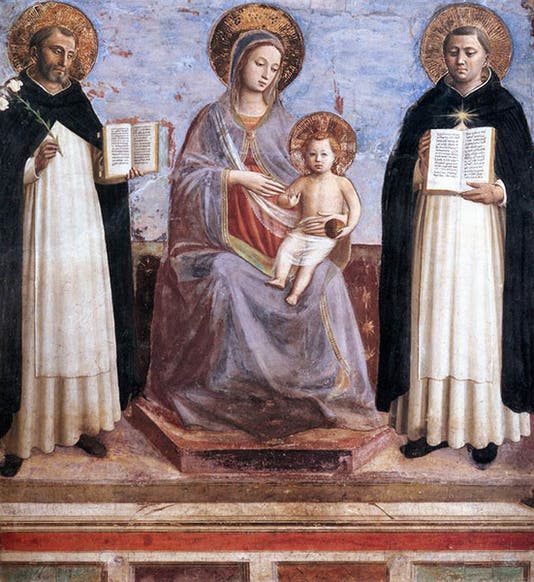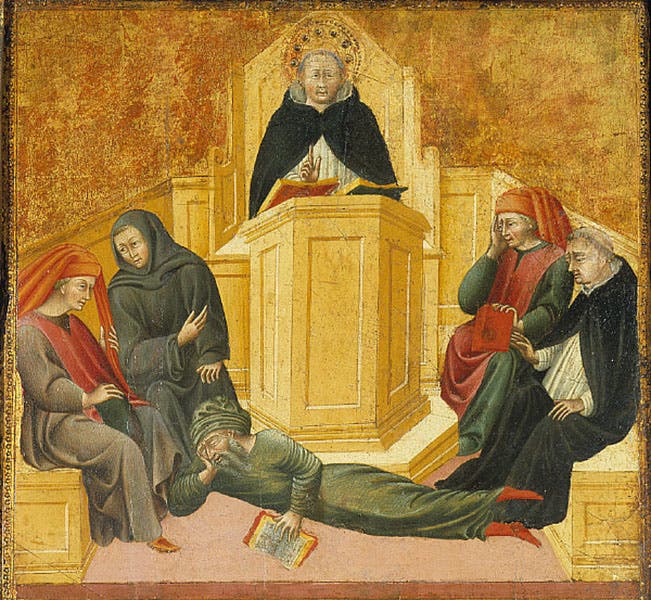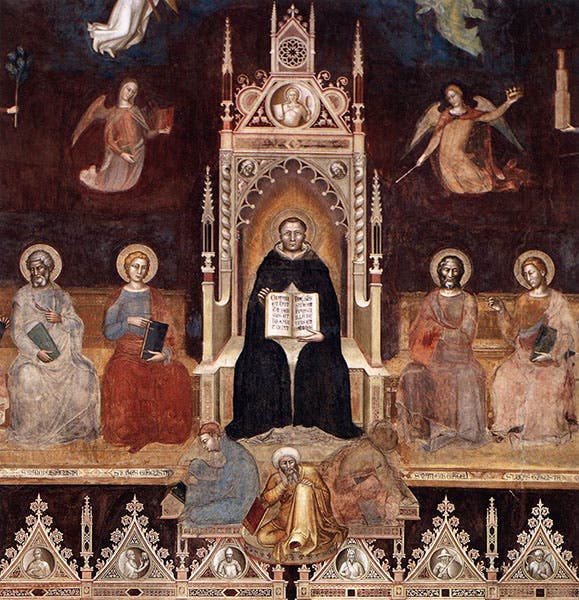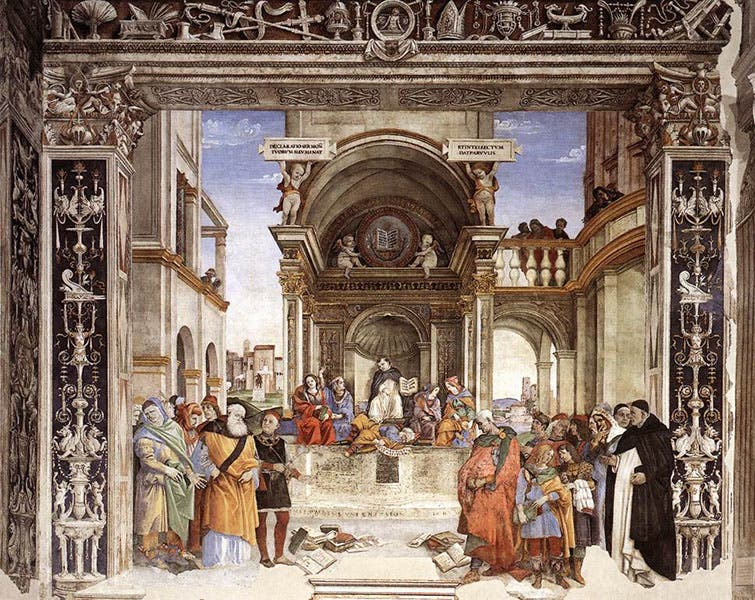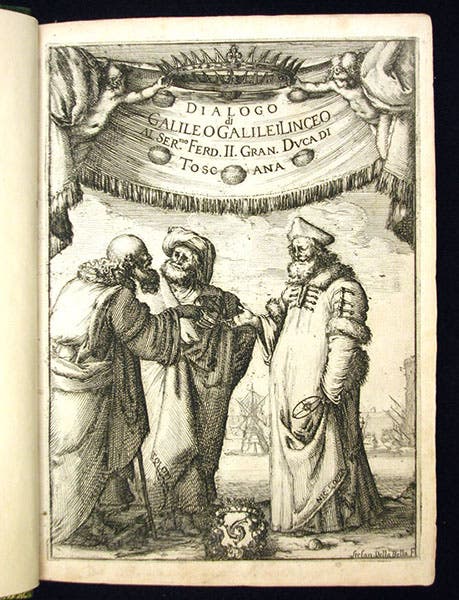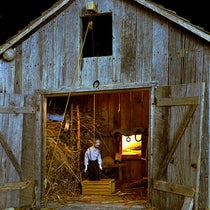Scientist of the Day - Thomas Aquinas
Thomas Aquinas, a Dominican friar and philosopher, was born Jan. 28, 1225. Most people know of Thomas as a theologian and a Doctor of the Catholic Church. In fact, Thomas was also one of the fathers of medieval science, although perhaps midwife might be the more appropriate term. Thomas taught at the University of Paris (and other universities) at a time when the complete works of Aristotle were just becoming available in the West (having been translated from the Arabic in the aftermath of the recovery of Spain from the Moors in the 12th century). Thomas found in Aristotle just what was missing from Christian theology: a complete system of logic, cosmology, physics, and metaphysics. Aristotle was imported whole hog into the curriculum, with his works becoming the foundation for the first two years of university studies. Granted, there had to be some gerrymandering done to make Aristotle fit into the Christian system, since Aristotle espoused such inconvenient doctrines as the eternity of the world and the mortality of the individual soul. But a fit was found, and the resulting synthesis came to be called scholasticism, the union of Christian theology and Aristotelian science and philosophy. Scholastic philosophers after Thomas spent as much time debating the mean speed theorem and the possible infinity of the world as they did original sin and the nature of the Trinity.
One of the other philosophers recovered during the great Age of Translation was Averroes, a 12th-century Muslim admirer of Aristotle who was not hindered by any Christian scruples and who tended to take Aristotle at his word on most matters, including the eternity of the world and the mortality of the soul. Thomas actually admired Averroes a great deal, but one of his principal goals was to stamp out heresy (he wrote an entire work against heretics), so Averroism (a term Thomas coined) came to symbolize for Thomas an unacceptable Aristotelian philosophy. When artists later began to commemorate Thomas, principally in frescoes on the walls of Dominican churches, they nearly always chose the theme of St Thomas Triumphant over Heresy for their paintings, and Averroes was invariably the principal heretic depicted. Our first example is by Giovanni di Paolo in the St. Louis Art Museum, painted around 1445 (second image, above). Averroes is lying at Thomas’s feet. (Giovanni is better known to historians of science for his painting of the Expulsion from the Garden, featuring a handsome depiction of the medieval geocentric cosmos; you can see the painting here).
An earlier and more elaborate fresco, by Andrea da Firenze, is in a chapel in the church of Santa Maria Novella in Florence; it was painted around 1366 and shows St. Thomas in the center, surrounded by a variety of prophets, patriarchs, and evangelists, with personifications of the seven liberal arts and the seven theological sciences down below. But below Thomas's feet are the trampled heretics, with Averroes being the central figure. We show a detail of the central scene (third image, above); you can see the complete painting here.
A third painting with a similar theme was executed by Filippino Lippi in the Carafa chapel of the church of Santa Maria sopra Minerva in Rome (fourth image, above). Painted around 1489 in the new Renaissance style, the figures are distributed throughout a realistic perspective space, which gives Averroes, at front left in the yellow tunic, much more prominent than Thomas himself, who is enthroned further back (see detail, fifth image, below)
I have long thought that Filippino’s Averroes strongly resembles the figure of Copernicus on the right side of the frontispiece of Galileo’s Dialogo (1632), a Copernicus who was impishly fashioned with the features of Galileo (sixth image, below). Galileo was tried in this very church, Santa Maria sopra Minerva, in 1633, on charges of heresy. So an observer at the trial, one who had brought a copy of the Dialogo with him, could have viewed the heretic Averroes on the wall, the heretic Copernicus in the book before him, and the alleged heretic Galileo in the dock, all looking eerily similar to one another. If that observer were a Dominican, as were many of the Inquisitors, with the inspiration of St. Thomas before him, he would have known what to do.
We have no contemporary portraits of Thomas Aquinas, so later artists simply painted him with features that they liked, although usually including the black cappa over a white habit that distinguished Dominicans from, say, the brown-robed Franciscans. If that is the case, we can choose the Thomas we like, and I choose the one in Fra Angelico’s, Virgin and Child with Saints Dominic and Thomas Aquinas, painted as a fresco ca 1445, but later transferred to canvas and available for viewing in The Hermitage (first image). Thomas is on the left, with the founder of the Dominican order, Dominic himself, on the right.
Dr. William B. Ashworth, Jr., Consultant for the History of Science, Linda Hall Library and Associate Professor emeritus, Department of History, University of Missouri-Kansas City. Comments or corrections are welcome; please direct to ashworthw@umkc.edu.

